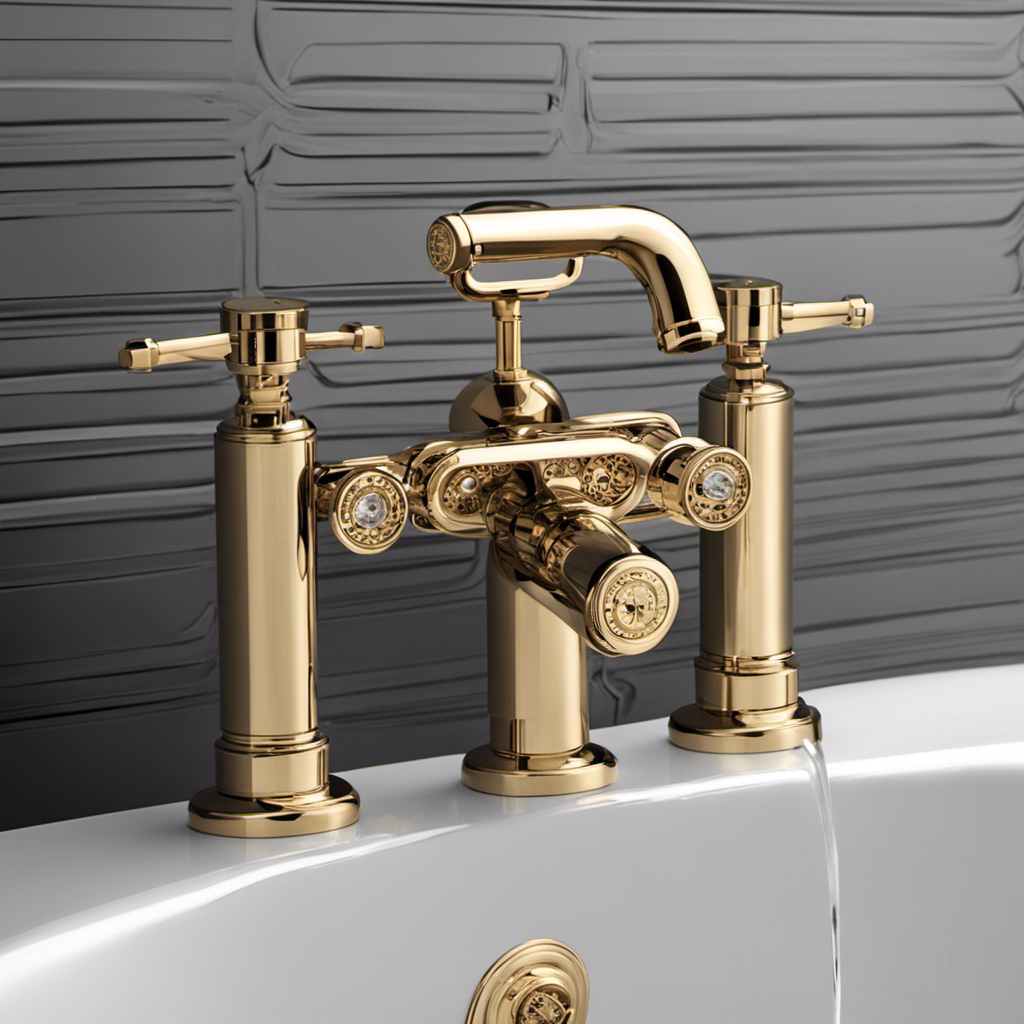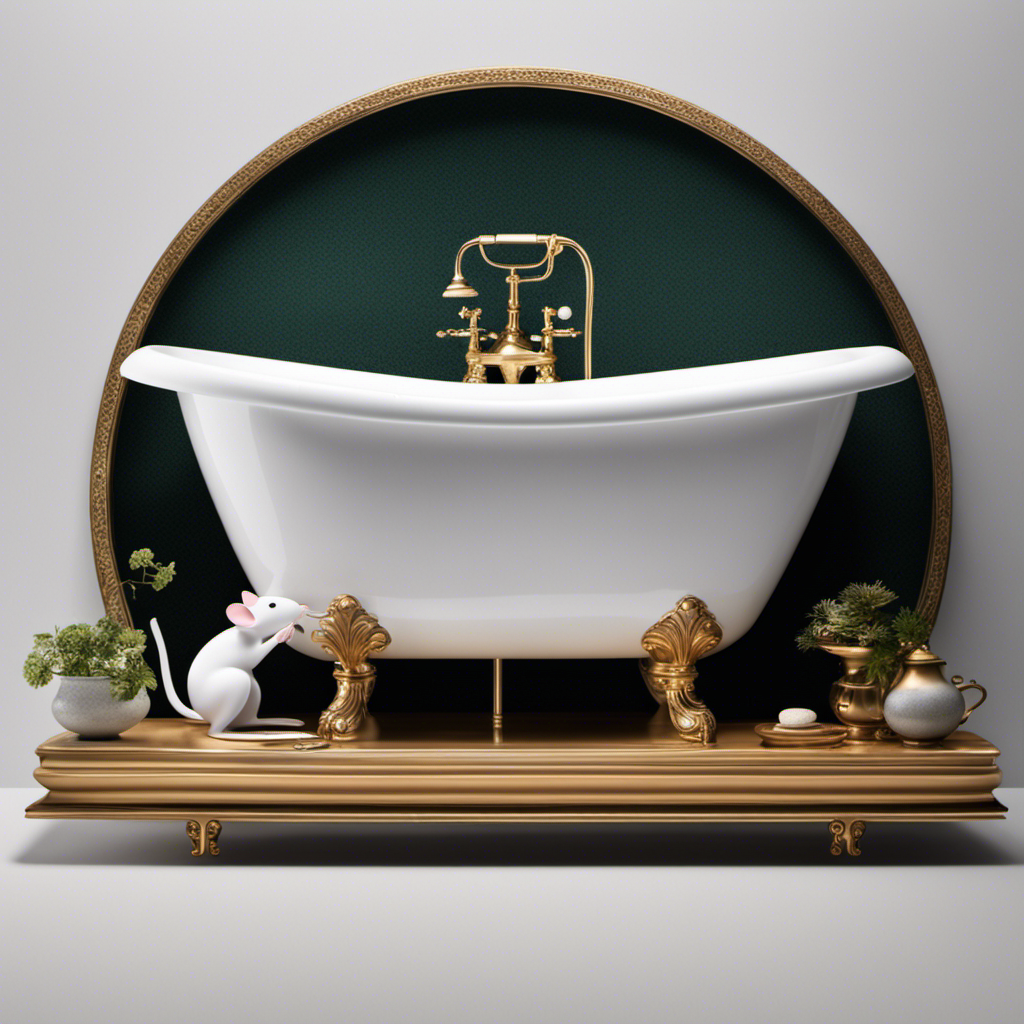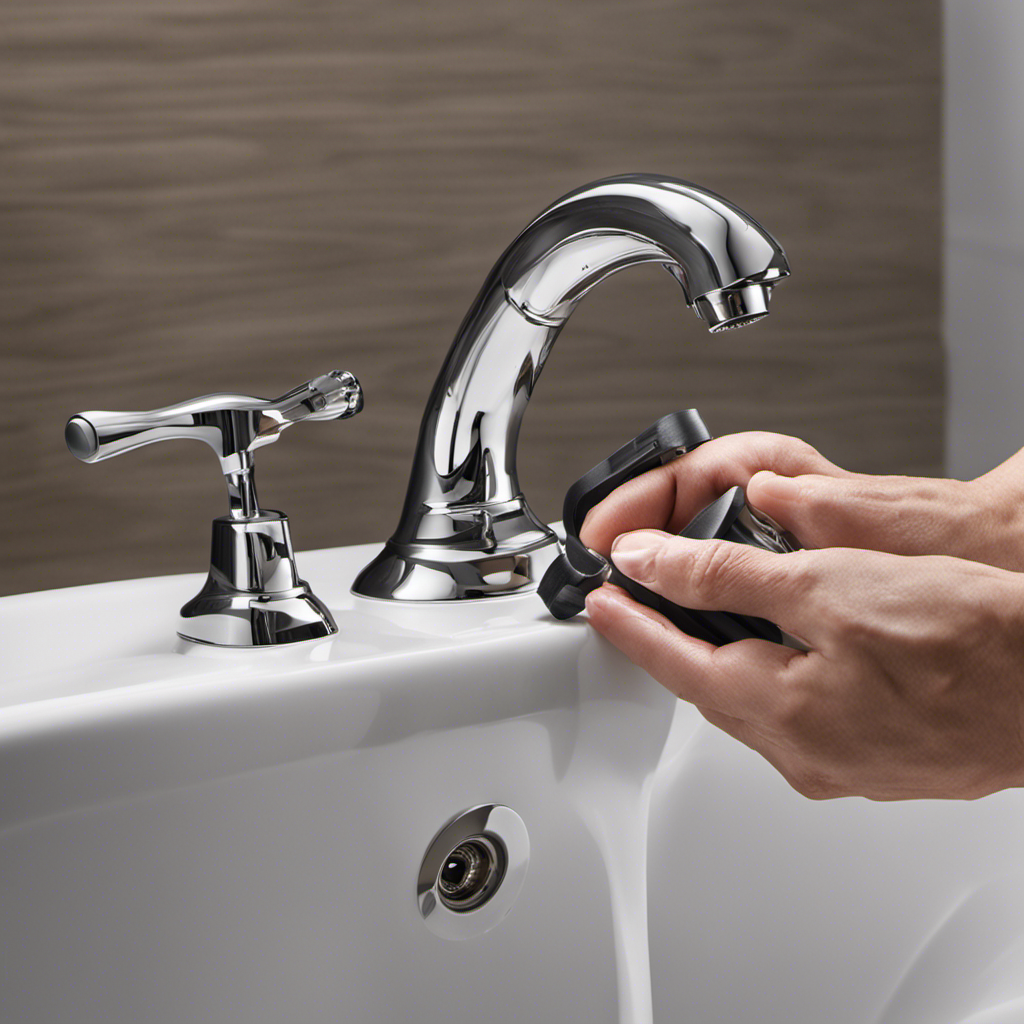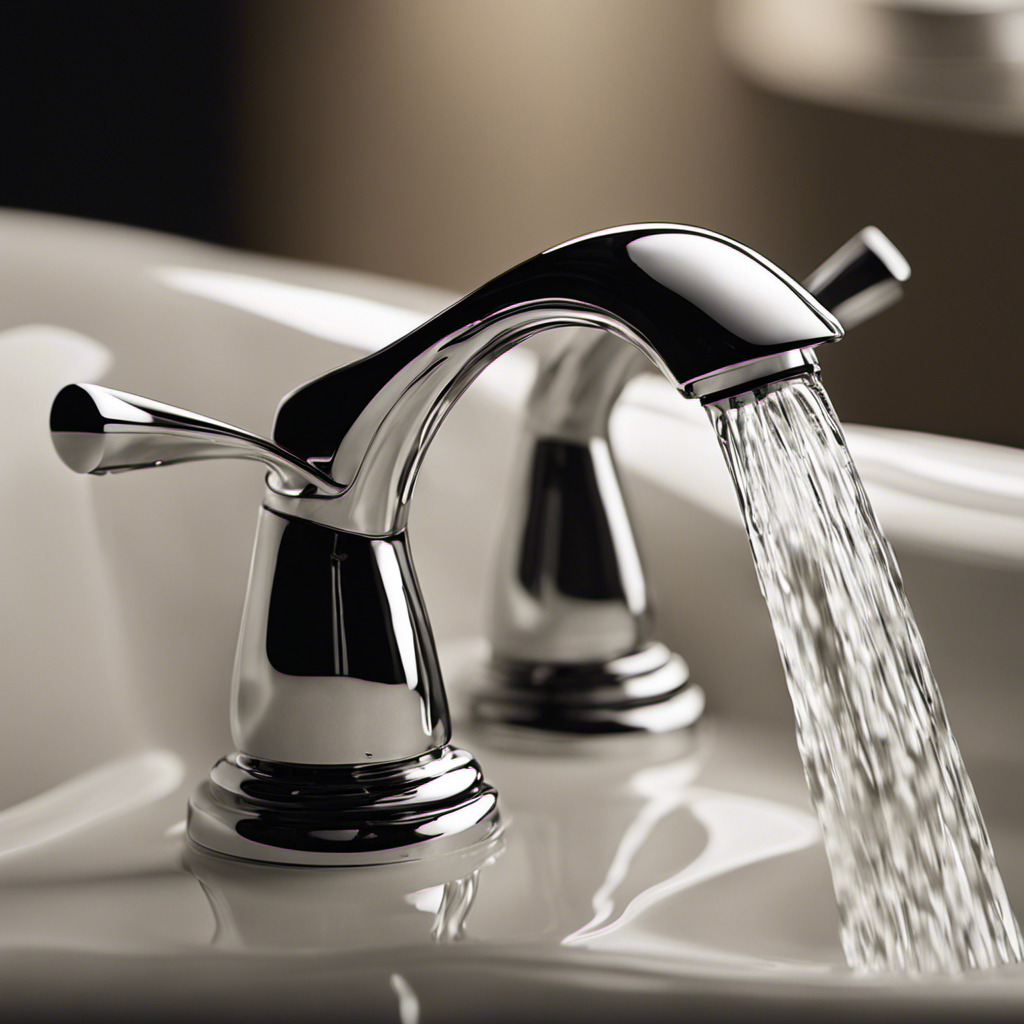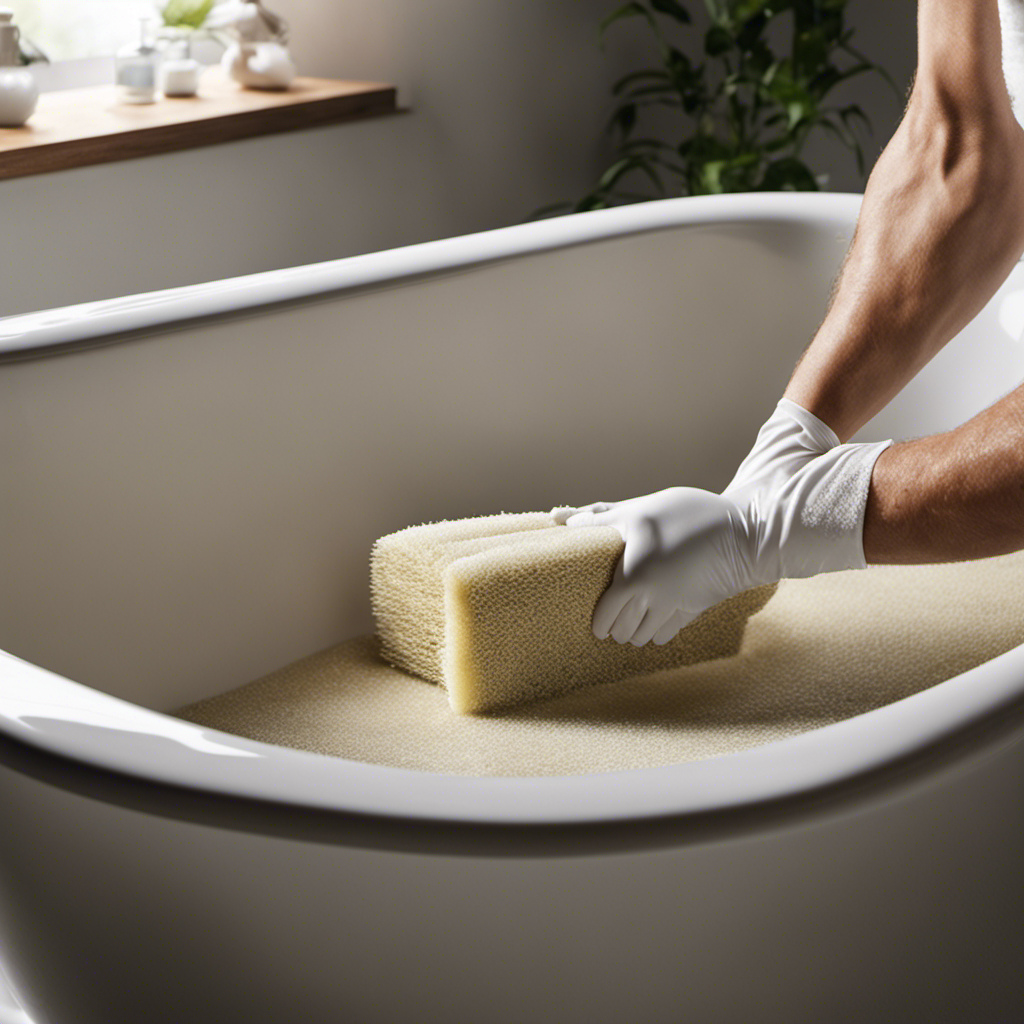I’m going to share with you exactly how a bathtub drain works.
Did you know that on average, a person spends about 8 minutes in the shower? Well, during those 8 minutes, a complex mechanism is at play to ensure that the water smoothly drains away.
In this article, I will break down the anatomy of a bathtub drain, explain the different types of drains, and delve into the role of the overflow drain.
So, let’s dive in and explore the fascinating world of bathtub drainage.
Key Takeaways
- The stopper controls the flow of water and is connected to a linkage mechanism housed inside the overflow pipe.
- The overflow pipe prevents the bathtub from overflowing and is connected to the drain pipe.
- There are different types of bathtub drains including pop-up drains, trip lever drains, toe-tap drains, and push-pull drains.
- The overflow drain plays a crucial role in preventing potential overflows, redirecting excess water, and acting as a backup for the main drain.
Anatomy of a Bathtub Drain
To understand the anatomy of a bathtub drain, you can start by examining the stopper and its components. The stopper is the part of the drain that controls the flow of water. It is typically made of metal or plastic and is attached to a lever or knob that allows you to open and close it.
The stopper is connected to a linkage mechanism, which is responsible for moving the stopper up and down. This mechanism is housed inside the overflow pipe, which is a vertical pipe that prevents the bathtub from overflowing. The overflow pipe is connected to the drain pipe, which carries the water out of the tub and into the plumbing system.
Understanding the anatomy of a bathtub drain is crucial for proper bathtub drain installation.
Now, let’s move on to the different types of bathtub drains.
Types of Bathtub Drains
When it comes to choosing the type of bathtub drain, there are a few key points to consider. Pop-up drains are operated by a lever or knob that pops up to open the drain and pushes down to close it. Trip lever drains, on the other hand, use a lever that you pull up to open the drain and push down to close it.
Toe-tap drains are activated by pressing down with your foot, while push-pull drains require you to push or pull a stopper to open or close the drain.
Each type has its own advantages and considerations, so it’s important to understand the differences before making a decision.
Pop-up or Trip Lever
The pop-up or trip lever allows water to drain out of the bathtub. These two types of bathtub drains have their own pros and cons. Let’s take a closer look at them in the table below:
| Pop-up | Trip Lever |
|---|---|
| Convenient to use | Requires manual operation |
| Provides a seamless look | May require regular maintenance |
| Can be easily adjusted | Limited design options |
The pop-up drain is convenient to use as it can be easily adjusted to control the water flow. It also provides a seamless look to the bathtub, enhancing its overall aesthetic appeal. However, the pop-up drain may require regular maintenance to keep it functioning properly.
On the other hand, the trip lever drain requires manual operation to open and close, which may not be as convenient. It also has limited design options compared to the pop-up drain. However, the trip lever drain is generally easier to maintain and less prone to malfunctioning.
Now that we have discussed the pros and cons of the pop-up and trip lever drains, let’s move on to the next section about the toe-tap or push-pull drains.
Toe-Tap or Push-Pull?
Are you wondering which type of drain is best for you: the toe-tap or push-pull? Let me break it down for you.
The toe-tap drain operates by simply pushing it with your foot, allowing for easy and convenient opening and closing. One of the main benefits of the toe-tap drain is its ease of use, especially for those with limited mobility or hand dexterity issues.
On the other hand, the push-pull drain requires manual pulling and pushing to open and close. This can be a disadvantage for some, as it may require more effort and can be less convenient. Additionally, the push-pull drain can sometimes become loose or malfunction over time, leading to potential leaks and maintenance issues.
Overall, if ease of use and convenience are important to you, the toe-tap drain may be the better choice.
The Role of the Overflow Drain in Bathtubs
The overflow drain in bathtubs serves a crucial purpose in preventing potential overflows. It acts as a safety feature by redirecting excess water away from the tub and into the drainage system. This helps to prevent water damage and potential accidents caused by overflowing water.
Additionally, the presence of an overflow drain enhances the overall safety of the drainage system by ensuring that it can effectively handle any sudden increase in water volume.
Overflow Drain Purpose
Don’t forget to consider the purpose of the overflow drain in your bathtub. The overflow drain plays a crucial role in preventing overflows and troubleshooting issues.
This drain is designed to catch excess water when the bathtub is filled to its maximum capacity. It works by diverting the water towards a secondary drain pipe, which leads to the main drain system. In case the main drain becomes clogged or overwhelmed, the overflow drain acts as a backup, ensuring that the excess water is safely drained away.
Understanding the purpose of the overflow drain is essential for maintaining the functionality of your bathtub and preventing potential overflows.
Now, let’s explore some effective methods to prevent bathtub overflows and keep your bathroom safe and dry.
Preventing Bathtub Overflows
To prevent bathtub overflows, you should regularly check the water level and avoid filling it too high. It is crucial to maintain awareness of the water level to prevent potential damage and water spillage.
Here are some key steps to prevent clogs and troubleshoot overflow issues:
- Ensure the overflow drain cover is securely in place.
- Clean the overflow drain regularly to remove any debris or buildup.
- Use a plunger or drain snake to clear any clogs in the drain pipe.
- Install an overflow drain alarm to alert you when the water level is reaching capacity.
- If the issue persists, consult a professional plumber to inspect the bathtub’s drainage system.
Drainage System Safety
Regularly maintaining your bathroom’s drainage system can help prevent potential issues and ensure the safety of your home. When it comes to the importance of proper bathtub drainage, it is crucial to understand how it functions and the potential risks involved.
A bathtub drain is designed to remove water and other waste materials efficiently. However, over time, debris such as hair, soap scum, and mineral deposits can accumulate and clog the drain, leading to slow drainage or even complete blockage. This not only affects the functionality of your bathtub but also poses a risk of overflow and water damage to your home.
To avoid such problems, it is essential to perform regular drainage system maintenance. This includes using drain guards, cleaning the drain regularly, and seeking professional help if needed.
Understanding the Drain Stopper Mechanism
The drain stopper mechanism in a bathtub allows water to flow in or out depending on its position. Understanding drain stopper maintenance is crucial to ensure proper functioning and prevent common issues. Here are some important points to consider:
-
Regular Cleaning:
-
Remove hair and debris regularly to prevent clogs.
-
Use a brush or toothpick to clean hard-to-reach areas.
-
Troubleshooting Common Issues:
-
If the stopper is not sealing properly, check for any debris or damage.
-
If the stopper is stuck in the closed position, try lubricating the mechanism or adjusting the linkage.
Proper maintenance of the drain stopper will prolong its lifespan and prevent costly repairs. By following these steps, you can keep your bathtub drain stopper working efficiently and avoid potential problems.
How Water Flows Through a Bathtub Drain
Now that we understand how the drain stopper mechanism works, let’s delve into how water flows through a bathtub drain. Proper shower drain maintenance and water pressure control are essential factors in ensuring a smooth and efficient flow.
When the bathtub faucet is turned on, water enters the bathtub through the spout. The water pressure created by the plumbing system propels the water through the pipes and into the bathtub. Once in the tub, gravity takes over, causing the water to flow towards the drain.
To maintain good water flow and prevent clogs, regular shower drain maintenance is necessary. This involves removing any debris or hair that may have accumulated in the drain. Additionally, controlling water pressure is crucial. High water pressure can strain the drain system and potentially cause leaks or damage.
Common Problems With Bathtub Drains
If you experience slow water flow or standing water in your bathtub, it may indicate a common problem with your drain. There are a few potential issues that could be causing this, including clogs and blockages within the drain pipe or the drain trap.
Some common problems with bathtub drains include:
-
Clogged drain pipe: Over time, hair, soap scum, and other debris can accumulate in the drain pipe, leading to a slow or blocked water flow.
-
Malfunctioning drain trap: The drain trap is designed to prevent odors and gases from entering your bathroom. If it becomes damaged or clogged, it can cause water to back up into the bathtub.
Understanding these common problems with bathtub drains is the first step in troubleshooting and resolving the issue. In the next section, we will discuss tips and tricks for maintaining a healthy bathtub drain, ensuring smooth water flow, and preventing future problems.
Tips and Tricks for Maintaining a Healthy Bathtub Drain
To keep your bathtub drain running smoothly, you should regularly clean it using a mixture of vinegar and baking soda. This simple and effective solution helps to maintain drain cleanliness and prevent clogs.
Troubleshooting drain clogs can be a hassle, but with proper maintenance, you can minimize the occurrence of such issues. Here are some tips and tricks for maintaining a healthy bathtub drain:
-
Use a drain strainer: This helps to catch hair and other debris before they enter the drain and cause clogs.
-
Flush with hot water: Once a week, pour a pot of boiling water down the drain to dissolve any buildup and keep it flowing freely.
-
Regularly clean with vinegar and baking soda: Mix equal parts vinegar and baking soda, pour it down the drain, and let it sit for about 30 minutes. Then, flush with hot water to remove any residue and eliminate odors.
Conclusion
In conclusion, understanding how a bathtub drain works is essential for maintaining a healthy and efficient drainage system. By knowing the anatomy of a bathtub drain, the types of drains available, and the role of the overflow drain, you can troubleshoot common problems and keep your drain functioning optimally.
Remember, a stitch in time saves nine, so regular maintenance and proper care will prevent major issues down the line. With a little know-how, you can keep your bathtub drain flowing smoothly like a well-oiled machine.
